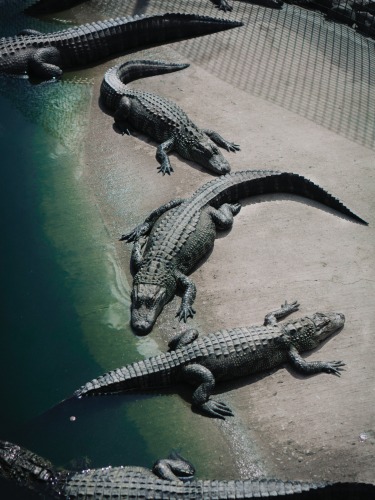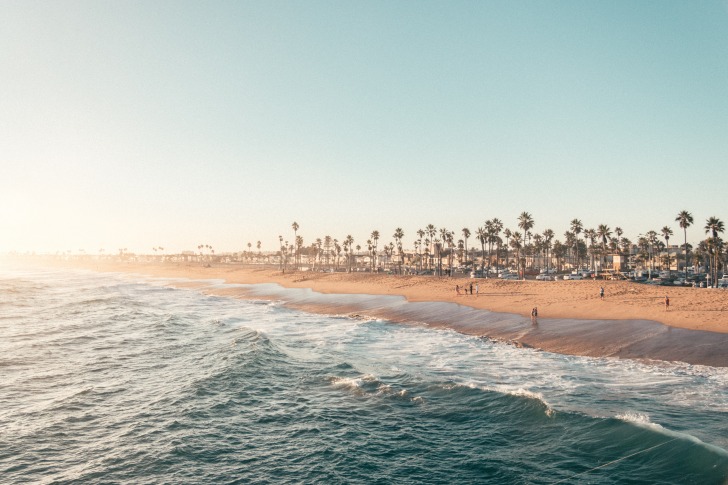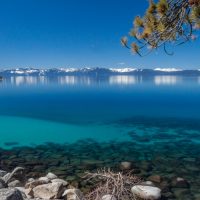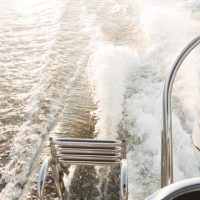California’s a large state, so it only makes sense that there are a lot of bodies of water.
Rivers, lakes, creeks, and streams are found from north to south, and that includes 10 major drainage basins.
Are there alligators living in any of those bodies of water?
It’s a good idea to know what may be lurking below the surface so you know whether it’s safe to go in.

Contents
So… Are There Alligators in California?
Alligators are not native to California.
The majority of alligators live in Florida, Louisiana, and Texas.
They stick to the warmer weather where they can also find plenty of sources of freshwater.
Although alligators aren’t native to California, that doesn’t mean you won’t find them in the wild periodically.
You’ll find reports here and there of the California Department of Fish and Wildlife locating alligators in creeks and lakes.
For example, a four-foot alligator was found in a Fremont, California creek in 2016, resulting in game wardens euthanizing the animal.
How do alligators end up in California if they aren’t native, you might be asking?
It depends on where you find them.
If they are at a zoo or preservation area, they have been brought in by conservationists or zoologists.
If they are found in the wild, it is likely because someone was keeping an alligator as a pet and decided to release it into the wild.
Unfortunately, the latter happens relatively often – and it’s also the reason for so many non-native snakes being found in the state as well.
There are actually many pets that are illegal to have in California – and both alligators and crocodiles are on that list.
The law prohibits people from obtaining permits to own them, import them, or farm them in the state of California.
Alligator Species in California
Alligators aren’t native to California, so you won’t find many of them at all.
There are only two species within the genus of alligators.
That includes the American Alligator and the Chinese Alligator.
The latter is only found within the provinces of eastern China.
If you do have an alligator sighting in California, it will be the American Alligator.
This is a four-legged reptile that can grow to be up to 1200 pounds and even 16 feet long.
The males are typically the larger of the species as females will typically not grow to be more than 10 feet long.
American alligators spend their time in freshwaters, such as swamps and marshes.
Every now and again, they’ll wander into a lake or creek if they can find enough of a food source.
The skin along the back of an American alligator is covered in bony plates known as scutes.
They have five toes on their front legs and four on their back ones.
This species is known for having a very strong tail and can actually use it to swat things out of its way.
Is It Safe to Swim in California?
California offers a lot of bodies of water, so it’s important to pay attention to where you want to swim.
When it comes to lakes, some of the most popular places for swimming include Lake Tahoe, Shasta Lake, Donner Lake, and Silverwood Lake.
It’s common to see people not only swimming in these lakes but participating in various watersports.
You’ll want to follow local guidelines.
In some instances, there may be a bacterial problem with the water – and then it’s advised that you don’t go in.
When it comes to beaches, there are places all along the west coast that offer prime spots into the Pacific Ocean.
You’ll be able to explore them – but again, check with the local guidelines to ensure that the water is clean.
It is highly unlikely that you’d encounter an alligator in any of the areas where you’d want to swim in California.
Even shark sightings aren’t that common.
The main issue would be the water quality – and you can check the California Water Quality Monitoring Council’s website to see if there are particular issues going on based on when you plan to go into the water.

Interesting Alligator Facts in California
There are all sorts of weird and interesting facts about alligators in California, so get ready to find out what’s going on in this state.
The California Academy of Sciences in San Francisco is home to Claude, an albino alligator.
You’ll be able to spot Claude right away since he is completely white.
The average gator is gray and brown with a tan underbelly.
However, every now and again, an alligator can be born without sufficient melanin to get its normal pigment.
It’s incredibly rare, which is why Claude is such a draw to the city’s science museum and aquarium.
One of the most popular items at the gift shop is a plushy “Claude the Alligator” toy.
If you hear about the Bay Area Gators, they aren’t talking about alligators.
It is actually a Football, Track & Field, and Cheer organization that is driven by the community of San Francisco Bay.
They’re totally harmless!
And once upon a time, there was actually an alligator farm where kids were able to ride and play with the gators.
This farm was opened in 1907 when Joseph Campbell relocated his alligator farm from Hot Springs, Arkansas to Los Angeles – and admission was only 25 cents when it first opened.
It moved to Buena Park and finally closed in 1984.
While it was open, people could enjoy encounters with alligators without fences, gates, or anything else standing between them and the reptiles.
Alligators vs. Crocodiles
Alligators and crocodiles are among the oldest predators in the world.
They’ve been on Earth for an estimated 200 years.
However, neither of them is native to California.
It is important to note some of the similarities and differences between these reptiles, though.
They will both eat their prey underwater.
They can eat anything that is abundant and accessible, including fish, turtles, frogs, birds, and even small mammals.
The larger the alligator or crocodile, the larger the animal they will feed on.
They are both considered opportunistic feeders, too, which means that they eat whenever they have the opportunity to do so.
If they cannot eat it all at once, they will sometimes store their kill underwater, such as near a log or tree root so that they can come back for it later.
They also have vertical-shaped pupils.
Here are where the differences come in.
Crocodiles have V-shaped snouts and crooked teeth.
Their colors are brown and green.
They also tend to live in salty water.
Alligators have rounded snouts and you won’t see their teeth with their mouths closed.
They tend to be brown and gray in color.
They also love freshwater and may be found in brackish water, too.
If you want to see alligators or crocodiles in California, you won’t find them in the wild.
The good news is that there are some zoos and conservation habitats where you can find both.
Consider checking out such places as the San Diego Zoo, Los Angeles Zoo, Oakland Zoo, Fresno Chaffee Zoo, and Happy Hollow Park & Zoo.
You’ll also want to be aware of the California crocodile, which is a relatively new species that have been discovered.
The first was spotted in 2005 and there have been more sightings in some urban and suburban neighborhoods, particularly around Cerritos, California.
The California crocodile has only been found to measure around 14 inches – and researchers suspect these were full-grown adults.
They are timid and have hardly ever attacked humans. When they do attack, their bites have not caused many injuries.
3 Safety Tips for Swimming in Alligator-Infested Waters
Most bodies of water where alligators have been spotted will be identified as such.
It allows you to enter with extreme caution.
Whether there’s a sign or not, you’ll want to follow a few tips for your safety – and the safety of others.
- Don’t Feed the Gators: Alligators tend to be more of a nuisance when they are fed. And if they are still hungry when you’re done, they’re more likely to attack.
- Don’t swim at dusk or dark: You want full visibility in the water to see if there are alligators approaching, so go into the water when it’s light outside.
- Never swim alone: Be sure that you swim where others can see you so that help is available if needed.
Summary
Alligators rarely attack if they aren’t provoked, yet the idea of going into water where they are swimming around can still be terrifying.
As you explore California and its history with alligators, you will find that the likelihood of encountering one outside of a zoo is very rare.
The American Alligator is not native to California, so they are not abundant in any of the freshwater bodies of water across the state.
You are more likely to encounter one of the reptiles in a state like Florida or Louisiana.
For the most part, it is safe for you to go into any of the rivers, lakes, or oceans around California as there are not many animals that would see a human as prey.
Even if you were to spot an alligator, it likely wouldn’t be large enough to cause serious injury.
The state tests the waters and reports the various threats that exist.
If you are worried about an alligator or any other danger, take the time to do some research so you know whether it’s safe to go into the water.
California Safety Overview
READ THE FULL REPORT: California Safety Review
Safety Index:
- OVERALL RISK: MEDIUM
- TRANSPORT & TAXIS RISK: MEDIUM
- PICKPOCKETS RISK: MEDIUM
- NATURAL DISASTERS RISK: HIGH
- MUGGING RISK: MEDIUM
- TERRORISM RISK: MEDIUM
- SCAMS RISK: HIGH
- WOMEN TRAVELERS RISK: MEDIUM
Frequently Asked Questions
Could an alligator survive in California?
Yes.
There are plenty of swamps and marshes in California that contain enough fresh water and food that an alligator could survive.
However, since alligators aren’t native to the state, they would have to be introduced – and that wouldn’t be positive for the local ecosystem.
Are there more alligator attacks or shark attacks in California?
There are more shark attacks in California than alligator attacks.
There are no alligator attacks listed by the state in the past 10 years.
California is the third most common state for shark attacks, though only 24 have been fatal – with the last one taking place in 2021.
What is the most alligator-infested body of water in the U.S.?
Lake Jesup is found in Central Florida.
It has been estimated that there are 13,000 alligators living in the lake.












It is highly unlikely to encounter an alligator in California’s bodies of water, but it’s always important to be aware of potential dangers and follow safety guidelines when swimming.
No, there are no alligators in California.
I guess we should be worried about them in the south because they have so. many alligators but California we don’t have any unless they released a baby 🐊🍼 but nothing to worry about.